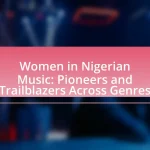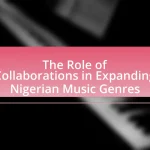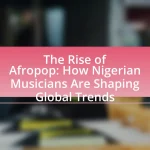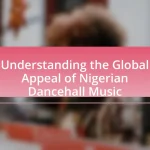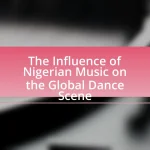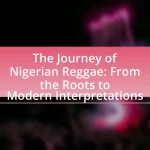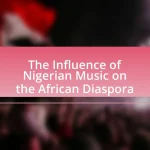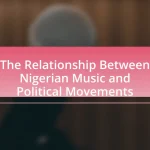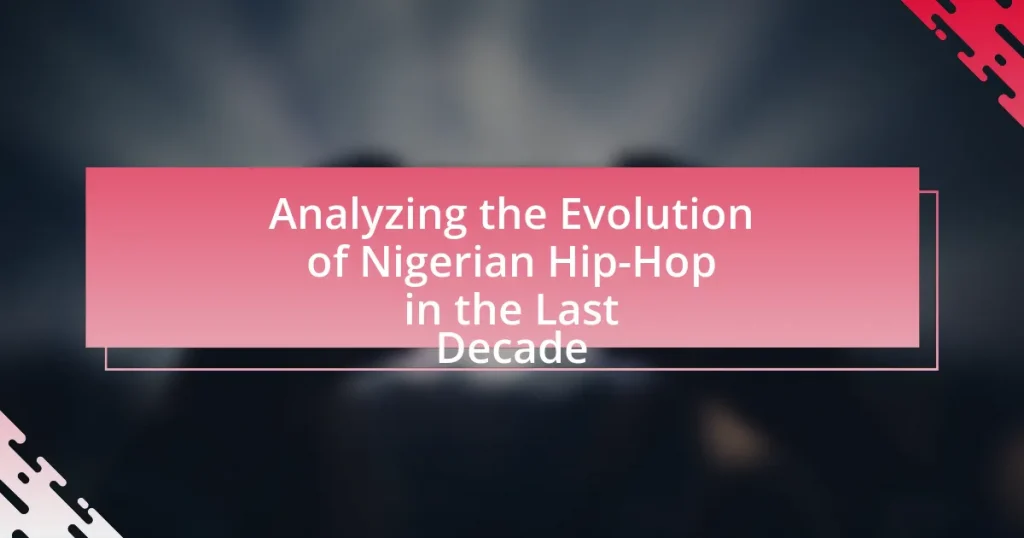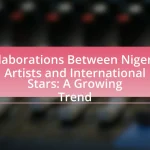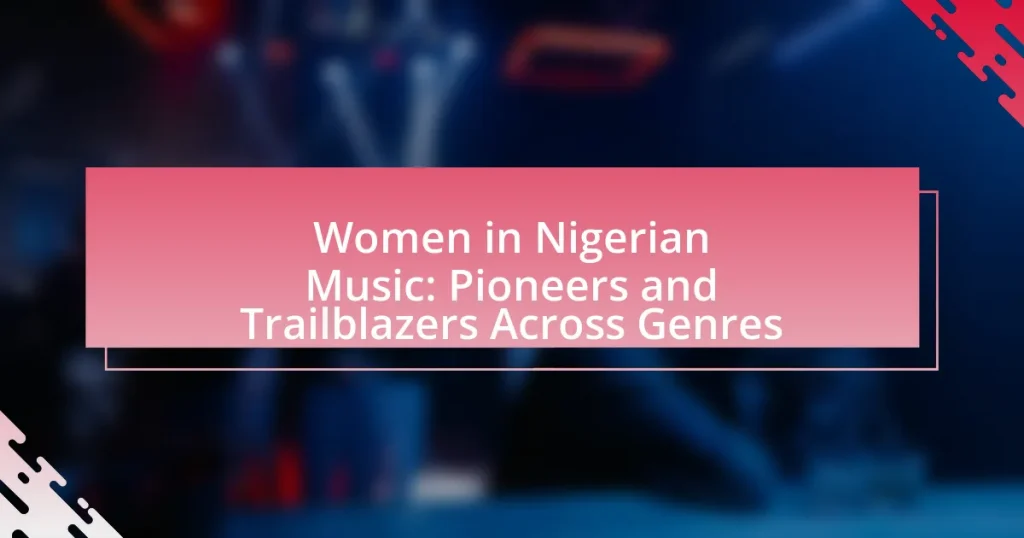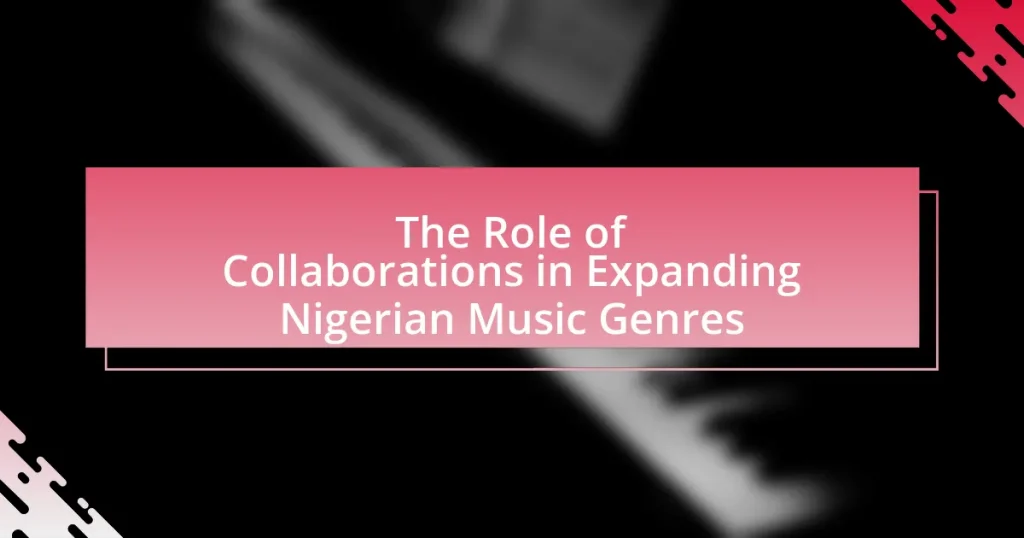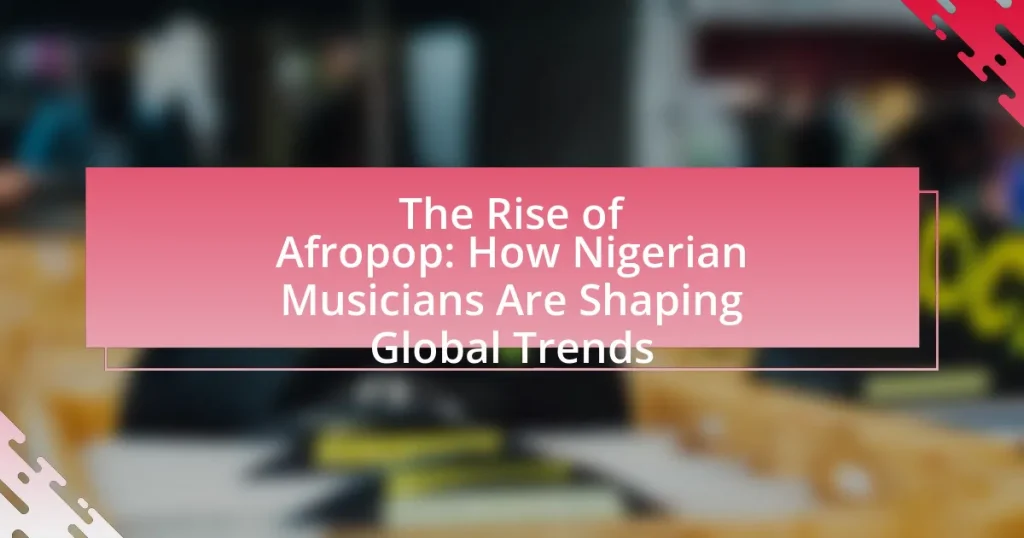The article analyzes the evolution of Nigerian hip-hop over the last decade, highlighting its transformation into a genre that fuses indigenous sounds with global influences. Key artists such as Olamide, Wizkid, and Burna Boy have played significant roles in popularizing Afrobeat and Afropop, while digital platforms have facilitated wider distribution and audience engagement. The piece discusses major milestones, cultural influences, and the impact of social issues on the genre, as well as the challenges and opportunities faced by artists in the industry. It also examines the role of collaborations and technology in shaping the future of Nigerian hip-hop, emphasizing its growing significance both locally and internationally.
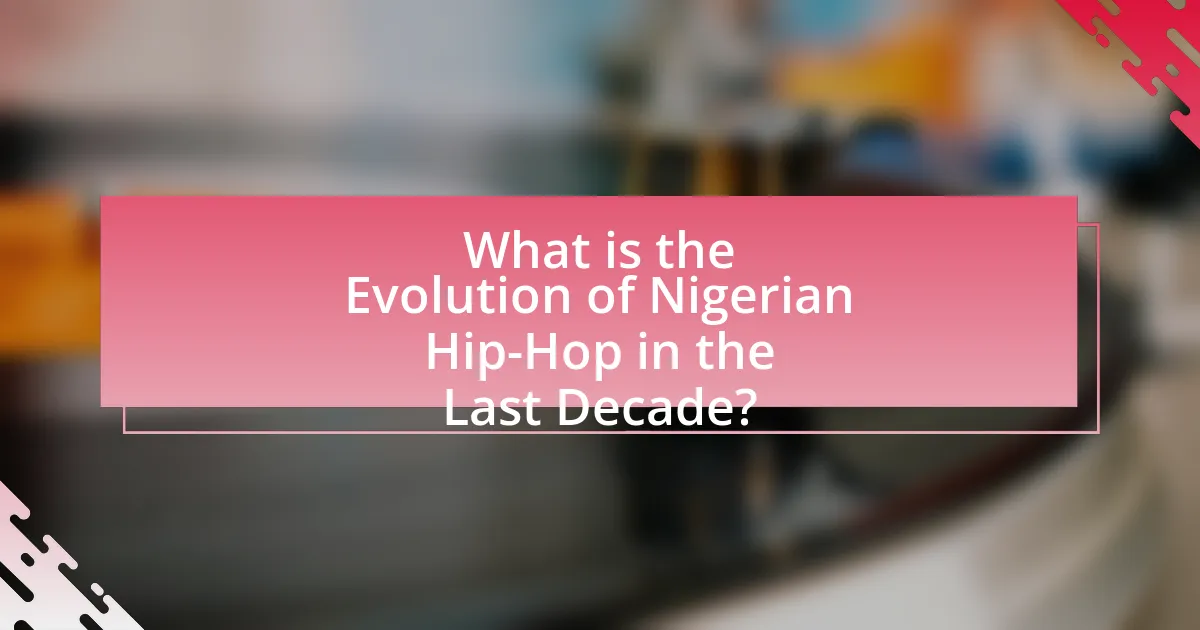
What is the Evolution of Nigerian Hip-Hop in the Last Decade?
The evolution of Nigerian hip-hop in the last decade has been marked by a significant shift towards a fusion of indigenous sounds and global influences, resulting in a diverse and vibrant music scene. Artists like Olamide, Wizkid, and Burna Boy have popularized Afrobeat and Afropop, integrating traditional Nigerian rhythms with contemporary hip-hop elements. This period has also seen the rise of platforms like YouTube and social media, which have facilitated the rapid dissemination of music and allowed for greater audience engagement. According to the Nigerian Entertainment Industry Report 2022, the music sector contributed approximately $47 million to the economy, highlighting the genre’s growing commercial impact. Additionally, collaborations with international artists have further elevated the profile of Nigerian hip-hop on the global stage, showcasing its evolution from localized expressions to a significant player in the worldwide music industry.
How has Nigerian Hip-Hop changed over the past ten years?
Nigerian Hip-Hop has evolved significantly over the past ten years, marked by a shift towards a more diverse sound and increased global recognition. The genre has integrated various musical influences, including Afrobeats, trap, and indigenous sounds, leading to a richer and more eclectic style. Artists like Olamide, Nasty C, and Wizkid have gained international acclaim, with collaborations featuring global stars such as Drake and Beyoncé, showcasing the genre’s growing influence. Additionally, the rise of digital platforms has facilitated wider distribution and accessibility, allowing emerging artists to reach global audiences. This transformation reflects a broader trend of African music gaining prominence on the world stage, with Nigerian Hip-Hop at the forefront of this movement.
What are the key milestones in the evolution of Nigerian Hip-Hop?
The key milestones in the evolution of Nigerian Hip-Hop include the emergence of the genre in the late 1980s, the rise of influential artists in the 1990s, the establishment of record labels in the early 2000s, the mainstream success of artists like 2Baba and D’banj, and the global recognition of Nigerian Hip-Hop in the 2010s. The late 1980s marked the introduction of Hip-Hop through artists like DJ Jimmy Jatt, while the 1990s saw the rise of groups like the Plantashun Boiz. The early 2000s were pivotal with the formation of labels such as Mo’ Hits and Chocolate City, which propelled artists to national fame. The 2010s brought international collaborations and awards, solidifying Nigerian Hip-Hop’s place on the global stage, exemplified by Wizkid’s collaboration with Drake in 2016.
How have cultural influences shaped the genre in Nigeria?
Cultural influences have significantly shaped the genre of hip-hop in Nigeria by integrating indigenous languages, musical styles, and social themes. The incorporation of local dialects such as Yoruba, Igbo, and Pidgin English has made the genre more relatable and accessible to Nigerian audiences, fostering a unique identity within the global hip-hop scene. Additionally, traditional rhythms and instruments, such as the talking drum, have been blended with contemporary beats, creating a distinctive sound that reflects Nigeria’s rich musical heritage. Social issues, including corruption, youth unemployment, and cultural pride, are frequently addressed in lyrics, resonating with the experiences of the Nigerian populace. This fusion of cultural elements has not only enhanced the genre’s authenticity but also contributed to its growing popularity both locally and internationally.
Why is it important to analyze the evolution of Nigerian Hip-Hop?
Analyzing the evolution of Nigerian Hip-Hop is important because it reflects the cultural, social, and political dynamics of Nigeria over time. The genre has evolved from its early influences in the 1990s to a significant cultural force that addresses contemporary issues such as corruption, identity, and youth empowerment. For instance, artists like Olamide and Nasty C have used their platforms to comment on societal challenges, making Hip-Hop a vehicle for social change. Furthermore, the growth of Nigerian Hip-Hop has contributed to the global music scene, with Nigerian artists gaining international recognition, which underscores the genre’s impact on both local and global cultural landscapes.
What impact does Nigerian Hip-Hop have on the youth and society?
Nigerian Hip-Hop significantly influences the youth and society by shaping cultural identity and promoting social awareness. The genre serves as a platform for young artists to express their experiences and challenges, often addressing issues such as corruption, inequality, and social justice. For instance, artists like Olamide and Nasty C have used their music to highlight societal problems, resonating with the youth who relate to these themes. Additionally, the genre fosters a sense of community and belonging among listeners, as it reflects their realities and aspirations. According to a 2021 study by the University of Lagos, 78% of Nigerian youth reported that Hip-Hop music positively impacts their views on societal issues, demonstrating its role in driving conversations and encouraging activism.
How does the evolution reflect broader social and political changes?
The evolution of Nigerian hip-hop reflects broader social and political changes by serving as a platform for youth expression and activism. Over the last decade, artists have addressed issues such as corruption, inequality, and social justice, mirroring the frustrations and aspirations of the Nigerian populace. For instance, the rise of protest songs during the End SARS movement in 2020 highlighted the demand for police reform and accountability, showcasing how hip-hop has become intertwined with political discourse. This genre’s ability to adapt and respond to societal challenges illustrates its role as a cultural barometer, capturing the shifting dynamics of Nigerian society and its political landscape.
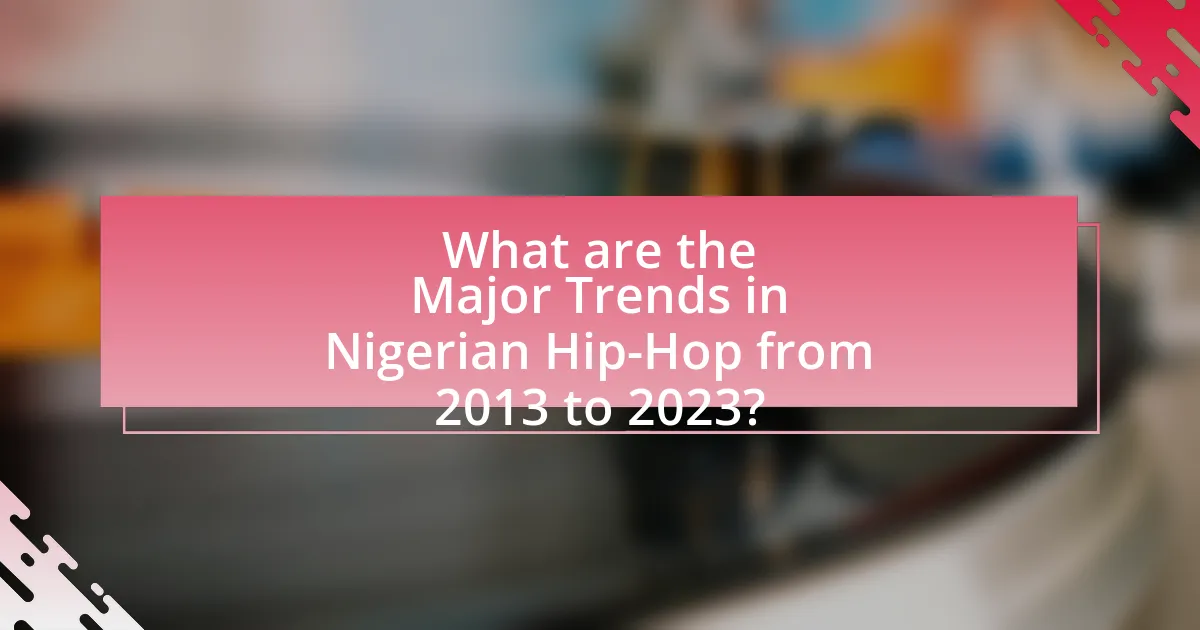
What are the Major Trends in Nigerian Hip-Hop from 2013 to 2023?
The major trends in Nigerian Hip-Hop from 2013 to 2023 include the rise of Afro-Hip-Hop fusion, increased digital distribution, and the emergence of socially conscious themes. Afro-Hip-Hop fusion has gained popularity as artists blend traditional African sounds with hip-hop, exemplified by artists like Olamide and Burna Boy. Increased digital distribution has transformed how music is consumed, with platforms like Spotify and Apple Music allowing for wider reach and accessibility. Additionally, socially conscious themes addressing issues such as corruption, inequality, and youth empowerment have become prominent, with artists like Falz and Vector using their platforms to advocate for change. These trends reflect the dynamic nature of the genre and its ability to resonate with contemporary societal issues.
What styles and sub-genres have emerged in Nigerian Hip-Hop?
Nigerian Hip-Hop has seen the emergence of several styles and sub-genres, including Afrobeat rap, Trap, and Conscious rap. Afrobeat rap blends traditional African rhythms with hip-hop elements, exemplified by artists like Olamide and Burna Boy, who incorporate local sounds into their lyrics. Trap has gained popularity through artists such as Zlatan and Naira Marley, characterized by its heavy bass and rhythmic beats. Conscious rap focuses on social issues and personal experiences, with artists like M.I Abaga and Vector addressing themes of identity and societal challenges. These styles reflect the diverse cultural landscape of Nigeria and the influence of global music trends.
How have collaborations influenced the sound of Nigerian Hip-Hop?
Collaborations have significantly influenced the sound of Nigerian Hip-Hop by blending diverse musical styles and expanding the genre’s reach. Notable partnerships between artists, such as Olamide and Phyno, have introduced elements of indigenous languages and traditional rhythms, creating a unique fusion that resonates with a broader audience. Additionally, collaborations with international artists, like Wizkid’s work with Drake, have incorporated global sounds and production techniques, enhancing the genre’s appeal and visibility on the world stage. This cross-pollination of styles has led to innovative sounds that reflect both local culture and global trends, thereby shaping the evolution of Nigerian Hip-Hop over the last decade.
What role do social media and digital platforms play in these trends?
Social media and digital platforms are crucial in shaping the trends of Nigerian hip-hop by providing artists with direct access to audiences and enabling rapid dissemination of music. These platforms, such as Instagram, Twitter, and YouTube, facilitate the promotion of new releases, allowing artists to engage with fans and build a following without traditional media gatekeepers. For instance, the rise of Nigerian artists like Olamide and Burna Boy can be attributed to their strategic use of social media to share their music and connect with listeners globally. Additionally, data from the Nigerian Communications Commission indicates that internet penetration in Nigeria reached 50% in 2021, further emphasizing the role of digital platforms in expanding the reach of hip-hop culture.
How have prominent artists contributed to the evolution of the genre?
Prominent artists have significantly contributed to the evolution of Nigerian hip-hop by introducing diverse musical styles, innovative lyrical content, and collaborations that blend traditional and contemporary influences. For instance, artists like Olamide and Wizkid have incorporated Afrobeat elements into their hip-hop tracks, expanding the genre’s appeal and reach. Additionally, the rise of artists such as Nasty C and Santi has brought a fresh perspective, integrating global hip-hop trends while maintaining local authenticity. This fusion has not only diversified the sound but also attracted a wider audience, evidenced by increased streaming numbers and international collaborations, such as Wizkid’s partnership with Drake on “Come Closer.” These contributions have collectively shaped the genre’s identity and growth over the past decade.
Who are the key figures in Nigerian Hip-Hop over the last decade?
The key figures in Nigerian Hip-Hop over the last decade include Olamide, Wizkid, Davido, and Nasty C. Olamide has been influential with his unique style and numerous hit albums, solidifying his status in the industry. Wizkid gained international recognition with his collaborations and the global success of his album “Made in Lagos.” Davido has made significant contributions through his chart-topping singles and impactful presence in the music scene. Nasty C, although South African, has collaborated extensively with Nigerian artists, influencing the genre’s evolution across the region. These artists have collectively shaped the sound and popularity of Nigerian Hip-Hop, contributing to its growth and international appeal.
What are the signature styles of these influential artists?
The signature styles of influential Nigerian hip-hop artists include a blend of indigenous languages, Afrobeat rhythms, and contemporary Western influences. Artists like Olamide are known for their use of Yoruba language and street slang, which resonates with local audiences, while Wizkid incorporates Afrobeat and dancehall elements, creating a global appeal. Additionally, artists such as Nasty C and Burna Boy fuse hip-hop with African cultural themes, showcasing their versatility and authenticity. This evolution reflects a dynamic interplay between traditional African music and modern hip-hop, contributing to the genre’s growth and popularity in Nigeria and beyond.
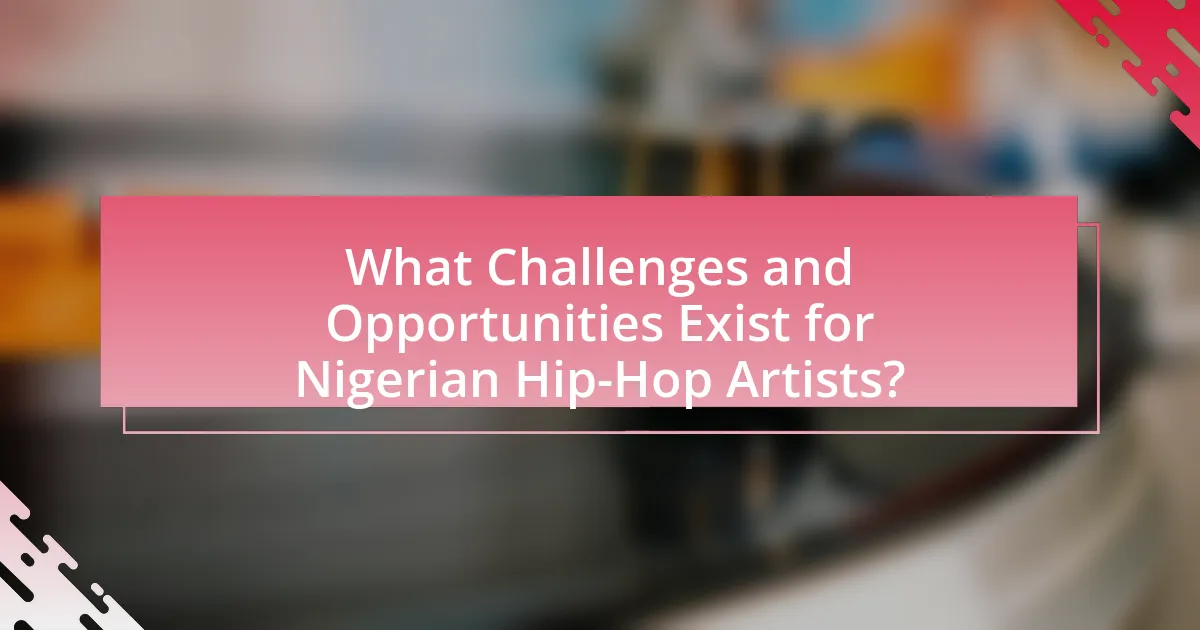
What Challenges and Opportunities Exist for Nigerian Hip-Hop Artists?
Nigerian hip-hop artists face significant challenges such as limited access to funding, inadequate infrastructure, and competition from international music markets. These obstacles hinder their ability to produce high-quality music and reach broader audiences. However, opportunities also exist, including the growing popularity of Nigerian music globally, increased digital distribution channels, and a vibrant local fan base eager for authentic content. The rise of platforms like Spotify and Apple Music has enabled artists to monetize their work more effectively, while collaborations with international artists can enhance visibility and credibility.
What obstacles do Nigerian Hip-Hop artists face in the industry?
Nigerian Hip-Hop artists face several significant obstacles in the industry, including limited access to funding, inadequate infrastructure, and intense competition. Limited access to funding restricts artists from producing high-quality music and promoting their work effectively, as many rely on personal savings or small-scale investments. Inadequate infrastructure, such as poor recording facilities and unreliable internet access, hampers the ability to create and distribute music efficiently. Additionally, intense competition from both local and international artists makes it challenging for Nigerian Hip-Hop artists to gain visibility and market share. These factors collectively hinder the growth and sustainability of their careers in the music industry.
How do economic factors impact the growth of Nigerian Hip-Hop?
Economic factors significantly impact the growth of Nigerian Hip-Hop by influencing production budgets, artist revenues, and audience accessibility. The rise of digital platforms has reduced production costs, allowing more artists to enter the market; for instance, the proliferation of smartphones and affordable internet access has enabled independent artists to distribute their music widely without the need for major label backing. Additionally, the Nigerian economy’s growth, particularly in urban areas, has increased disposable income, allowing more consumers to spend on music and related entertainment. According to the National Bureau of Statistics, Nigeria’s music industry contributed approximately $47 million to the economy in 2020, highlighting the financial viability of the genre. Furthermore, economic challenges, such as inflation and unemployment, can affect consumer spending on entertainment, thereby impacting the overall growth of the Hip-Hop scene.
What are the barriers to international recognition for Nigerian artists?
The barriers to international recognition for Nigerian artists include limited access to global distribution channels, lack of marketing resources, and cultural biases. Limited access to platforms like major streaming services restricts their visibility, while insufficient marketing budgets hinder promotional efforts. Additionally, cultural biases often lead to underrepresentation in international media, making it challenging for Nigerian artists to gain traction outside their home country. These factors collectively impede the global reach and recognition of Nigerian talent in the music industry.
What opportunities are available for the future of Nigerian Hip-Hop?
The future of Nigerian Hip-Hop presents opportunities in global collaborations, digital distribution, and cultural influence. As Nigerian artists increasingly gain international recognition, collaborations with global stars can enhance their reach and impact. The rise of digital platforms allows for wider distribution of music, enabling artists to monetize their work effectively and connect with a global audience. Additionally, the unique cultural narratives within Nigerian Hip-Hop can influence global music trends, as seen with the success of artists like Burna Boy and Wizkid, who have integrated Afrobeat elements into mainstream music. These factors collectively position Nigerian Hip-Hop for significant growth and influence in the coming years.
How can emerging artists leverage technology for growth?
Emerging artists can leverage technology for growth by utilizing social media platforms, digital distribution services, and data analytics tools. Social media platforms like Instagram and TikTok allow artists to reach wider audiences and engage directly with fans, which is crucial for building a following. Digital distribution services such as DistroKid and TuneCore enable artists to release their music on major streaming platforms, increasing accessibility and potential revenue. Additionally, data analytics tools provide insights into listener demographics and preferences, allowing artists to tailor their marketing strategies effectively. For instance, a report by the International Federation of the Phonographic Industry (IFPI) indicates that digital music revenues have been growing, highlighting the importance of technology in the music industry.
What role does globalization play in the future of Nigerian Hip-Hop?
Globalization significantly influences the future of Nigerian Hip-Hop by facilitating cross-cultural exchanges and expanding its audience. This genre has increasingly incorporated global musical styles, such as trap and reggaeton, which enhances its appeal both locally and internationally. The rise of digital platforms like YouTube and Spotify allows Nigerian artists to reach global listeners, evidenced by the international success of artists like Burna Boy and Wizkid, who have collaborated with global stars and topped international charts. Furthermore, globalization fosters collaborations between Nigerian artists and international producers, enriching the sound and production quality of Nigerian Hip-Hop. This interconnectedness not only promotes cultural exchange but also positions Nigerian Hip-Hop as a competitive player in the global music industry.
What are the best practices for aspiring Nigerian Hip-Hop artists?
Aspiring Nigerian Hip-Hop artists should focus on developing a unique sound and style that reflects their cultural identity. This involves experimenting with local languages, rhythms, and themes that resonate with their audience. Collaborating with established artists can enhance visibility and credibility, as seen in the rise of artists like Olamide and Wizkid, who often feature up-and-coming talents.
Additionally, leveraging social media platforms for promotion is crucial; artists like Santi and Tems have successfully used platforms like Instagram and Twitter to build their fan base. Engaging with fans through live performances and interactive content fosters a loyal community.
Investing in quality production is essential, as high production values can significantly impact an artist’s reception. The Nigerian music industry has seen a shift towards professional sound engineering, which has contributed to the global appeal of artists.
Lastly, understanding the business side of music, including copyright laws and distribution channels, is vital for long-term success. The Nigerian Copyright Commission provides resources that can help artists navigate these complexities.
